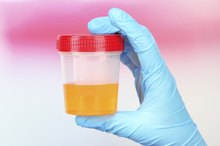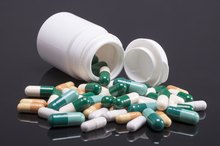Side Effects of Sulfa Antibiotics
Sulfa antibiotics are used to treat many common infections, but this drug class can cause a variety of side effects. A common oral formula, called TMP-SMX (Bactrim or Septra) combines sulfamethoxazole with the antibiotic trimethoprim. Whether you receive a sulfa antibiotic for a urinary tract infection, some other bacterial infection or even a parasitic infection, common reactions and rare but serious reactions are important to know about.
Common Side Effects
Sulfa antibiotics are generally safe and well tolerated. Nausea, vomiting, diarrhea and loss of appetite are the most common side effects. They may improve if you do not take your medication on an empty stomach. Another relatively common side effect is a minor rash that may be blotchy, slightly raised and itchy.
- Sulfa antibiotics are generally safe and well tolerated.
- They may improve if you do not take your medication on an empty stomach.
Severe Skin Reactions
Cephalexin 500 mg Side Effects
Learn More
Very rarely, sulfa antibiotics can cause extremely serious skin reactions, such as Stevens-Johnson syndrome and toxic epidermal necrolysis 5. Both of these conditions are characterized by a reddish rash that does not blanch -- turn white -- with pressure. It eventually leads to severe blistering and peeling. According to a September 2008 article in “Autoimmunity Reviews,” these are actually the same disease -- the only difference is that SJS affects a smaller amount of the body than TEN. Flulike symptoms, such as a fever, severe aches and fatigue, often occur before the rash appears. SJS and TEN both require immediate medical attention.
- Very rarely, sulfa antibiotics can cause extremely serious skin reactions, such as Stevens-Johnson syndrome and toxic epidermal necrolysis 5.
- Both of these conditions are characterized by a reddish rash that does not blanch -- turn white -- with pressure.
Liver Injury
Yellowing of the skin or whites of the eyes could be a sign of liver injury, a rare complication of sulfa antibiotic use. Nausea, severe fatigue and easy bruising can be other indications of liver problems. Sulfonamides, the group of drugs that includes sulfa antibiotics, cause 5 percent to 10 percent of all cases of drug-induced acute liver failure, according to the National Institutes of Health 4. Let your doctor know if you have any signs of liver problems while taking sulfa antibiotics.
- Yellowing of the skin or whites of the eyes could be a sign of liver injury, a rare complication of sulfa antibiotic use.
- Nausea, severe fatigue and easy bruising can be other indications of liver problems.
Blood-Related Reactions
Amoxicillin Antibiotic Side Effects
Learn More
Although very rare, sulfa antibiotics may cause serious blood disorders. These can include agranulocytosis -- a decreased number of infection-fighting white blood cells -- or thrombocytopenia -- a reduced number of blot-clotting platelets. Aplastic anemia, which is a rare cause of decreased red blood cell counts, may also occur. If you have extreme fatigue, pale skin or gums, or any new or worsening infection while taking sulfa antibiotics, contact your doctor immediately.
- Although very rare, sulfa antibiotics may cause serious blood disorders.
- Aplastic anemia, which is a rare cause of decreased red blood cell counts, may also occur.
Other Side Effects and Precautions
Other uncommon side effects include kidney problems, muscle damage and psychiatric or neurological problems, such as hallucinations and balance problems. People who are allergic to certain other sulpha drugs, such as the anti-HIV medications amprenavir and fosamprenavir, may also be allergic to sulfa antibiotics.
Sulfa antibiotics should not be taken by women who are pregnant or may become pregnant. Breast-feeding women and infants under the age of 2 months should also not take these medications. Having severe anemia due to folate deficiency is another situation when sulfa antibiotics should be avoided.
- Other uncommon side effects include kidney problems, muscle damage and psychiatric or neurological problems, such as hallucinations and balance problems.
- Breast-feeding women and infants under the age of 2 months should also not take these medications.
Warnings and Medication Interactions
Facial swelling, difficulty breathing or a feeling of your throat closing may be signs of a serious allergic reaction and require emergency care. At the first sign of a rash, stop taking the drug and see your doctor to determine whether it is the beginning of one of the severe skin reactions. Any other change in skin color or any unusual bleeding or bruising should also be reported to your doctor immediately.
Sulfa antibiotics may interact with many other medicines. Some examples include diuretics, the blood thinner warfarin (Coumadin) and antidepressants like amitriptyline (Elavil). If you are prescribed sulpha antibiotics, make sure you tell your doctor and pharmacist about all the medicines and supplements you are taking.
- Facial swelling, difficulty breathing or a feeling of your throat closing may be signs of a serious allergic reaction and require emergency care.
- At the first sign of a rash, stop taking the drug and see your doctor to determine whether it is the beginning of one of the severe skin reactions.
Related Articles
References
- National Library of Medicine DailyMed: Bactrim DS
- Canadian Family Physician: Approach to Managing Patients With Sulfa Allergy
- Southern Medical Journal: Practical Issues in the Management of Hypersensitivity Reactions: Sulfonamides
- NIH LiverTox: Sulfonamides
- Autoimmunity Reviews: Stevens–Johnson Syndrome and Toxic Epidermal Necrolysis
- Zawodniak, A.; Lochmatter, P.; Beeler, A. et al. Cross-reactivity in drug hypersensitivity reactions to sulfasalazine and sulfamethoxazole. Int Arch Allergy Immunol. 2010;153(2):152-6. doi:10.1159/000312632
- Wulf, N. and Matuszewski, K. Sulfonamide cross-reactivity: is there evidence to support broad cross-allergenicity? Am J Health Syst Pharm. 2013 Sep 1;70(17):1483-94. doi:10.2146/ajhp120291
- Schnyder B, Pichler WJ. Allergy to sulfonamides. J Allergy Clin Immunol. 2013;131(1):256-7.e1-5. doi:10.1016/j.jaci.2012.10.003
- Harr T, French LE. Toxic epidermal necrolysis and Stevens-Johnson syndrome. Orphanet J Rare Dis. 2010;5:39. doi:10.1186/1750-1172-5-39
- Meyer C, Behm N, Brown E, Copeland NK, Sklar MJ. An Adverse Drug Reaction to Trimethoprim-Sulfamethoxazole Revealing Primary HIV: A Case Report and Literature Review. Case Rep Infect Dis. 2015;2015:691010. doi:10.1155/2015/691010
- Platt D, Griggs RC. Use of acetazolamide in sulfonamide-allergic patients with neurologic channelopathies. Arch Neurol. 2012;69(4):527-9. doi:10.1001/archneurol.2011.2723
- Sulfite and Sulfa Drugs. American Academy of Asthma, Allergy, and Immunology.
- Joint Task Force on Practice Parameters, et al. Drug allergy: an updated practice parameter. Ann Allergy Asthma Immunol. 2010; 105(4):259-73. doi:10.1016/j.anai.2010.08.002
- Schnyder B, Pichler WJ. Allergy to sulfonamides. J Allergy Clin Immunol. 2013;131(1):256-7.e1-5. doi:10.1016/j.jaci.2012.10.003
- Zawodniak, A.; Lochmatter, P.; Beeler, A. et al. Cross-reactivity in drug hypersensitivity reactions to sulfasalazine and sulfamethoxazole. Int Arch Allergy Immunol. 2010;153(2):152-6. doi:10.1159/000312632
Resources
Writer Bio
Kari Oakes is a Maryland-based health and medical writer and a certified physician assistant. Her clinical experience in primary care and emergency medicine gives her real-world insight into a host of medical conditions and health concerns. Her work has appeared in HCPLive/Cardiology Review, DocGuide, FirstWord Pharma and Frontline Medical News.








